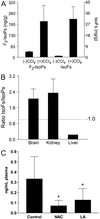Discovery of lipid peroxidation products formed in vivo with a substituted tetrahydrofuran ring (isofurans) that are favored by increased oxygen tension
- PMID: 12482927
- PMCID: PMC139209
- DOI: 10.1073/pnas.252649099
Discovery of lipid peroxidation products formed in vivo with a substituted tetrahydrofuran ring (isofurans) that are favored by increased oxygen tension
Abstract
Free radicals have been implicated in the pathogenesis of an increasing number of diseases. Lipids, which undergo peroxidation, are major targets of free radical attack. We report the discovery of a pathway of lipid peroxidation that forms a series of isomers in vivo that are characterized by a substituted tetrahydrofuran ring structure, termed isofurans (IsoFs). We have proposed two distinct pathways by which IsoFs can be formed based on 18O2 and H2 18O labeling studies. Measurement of F2-isoprostanes (IsoPs), prostaglandin F2-like compounds formed nonenzymatically as products of lipid peroxidation, is considered one of the most reliable approaches for assessing oxidative stress status in vivo. However, one limitation with this approach is that the formation of IsoPs becomes limited at high oxygen tension. In contrast, the formation of IsoFs becomes increasingly favored as oxygen tension increases. IsoFs are present at readily detectable levels in normal fluids and tissues, and levels increase dramatically in CCl4-treated rats, an animal model of oxidant injury. The ratio of IsoFs to IsoPs in major organs varies according to normal steady-state tissue oxygenation. In addition, IsoFs show a marked increase early in the course of hyperoxia-induced lung injury, whereas IsoPs do not significantly increase. We propose that combined measurement of IsoFs and IsoPs should provide a more reliable index of oxidant stress severity than quantification of either alone because of the opposing modulation of the two pathways by oxygen tension, which can vary widely in different organs and disease states.
Figures





References
-
- Roberts L. J., II & Morrow, J. D. (2000) Free Radical Biol. Med. 28, 505-513. - PubMed
-
- Pryor W. (2000) Free Radical Biol. Med. 28, 503-504. - PubMed
-
- Longmire A. J., Swift, L. L., Roberts, L. J., II, Awad, J. A., Burk, R. F. & Morrow, J. D. (1994) Biochem. Pharmacol. 47, 1173-1177. - PubMed
-
- Morrow J. D. & Roberts, L. J., II (1998) Methods Enzymol. 300, 3-12. - PubMed
Publication types
MeSH terms
Substances
Grants and funding
LinkOut - more resources
Full Text Sources
Other Literature Sources
Medical
Miscellaneous

